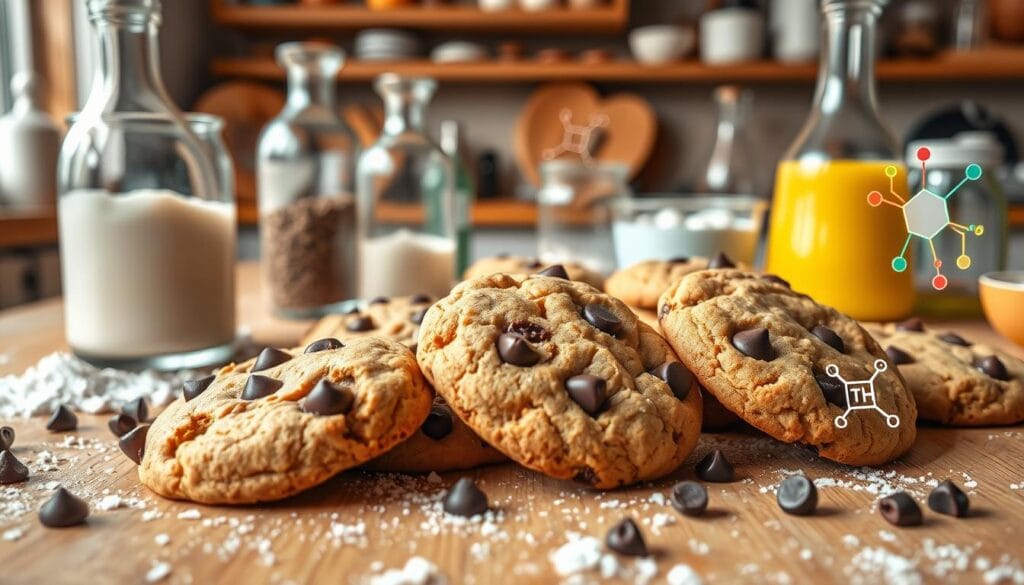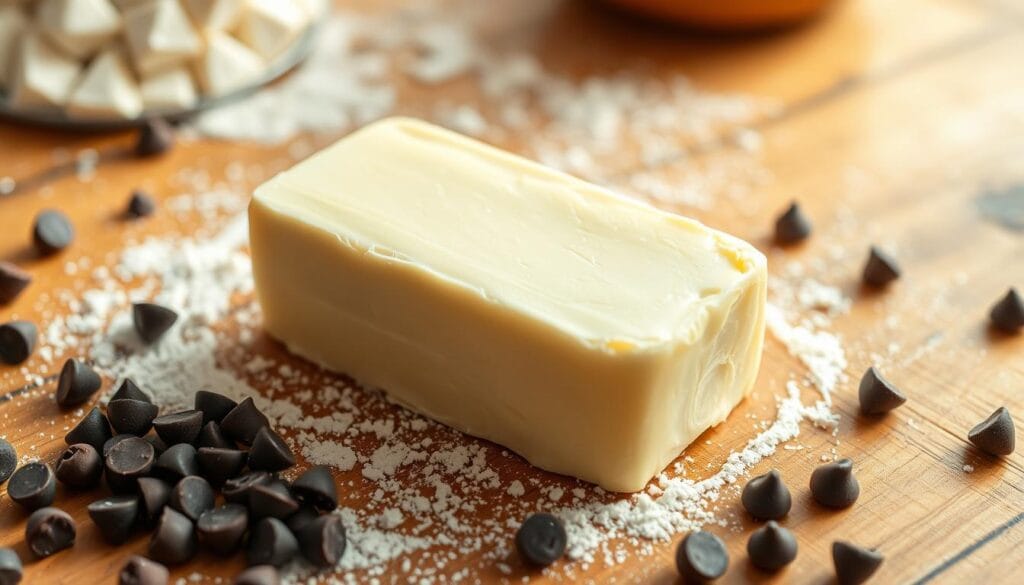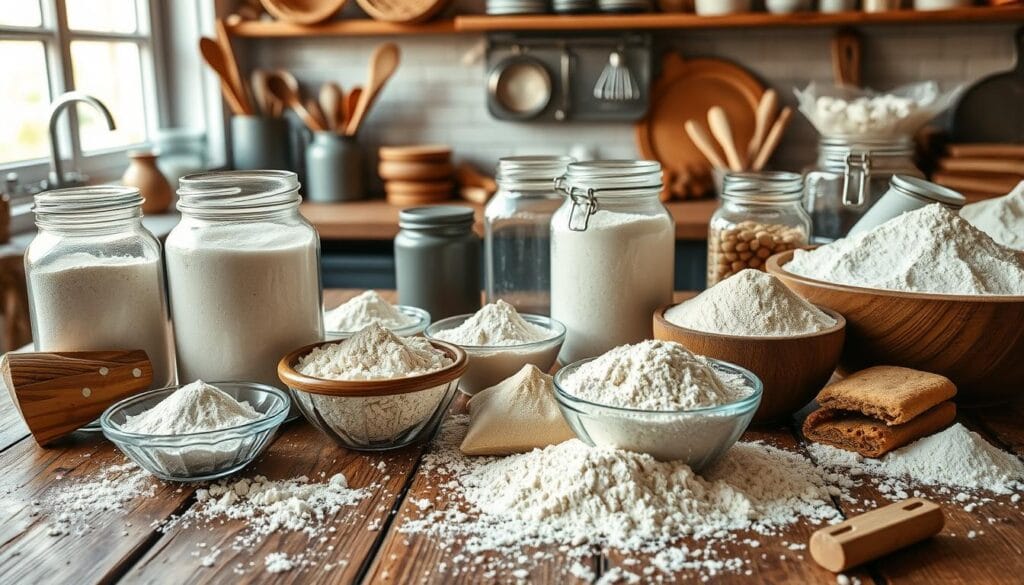There’s nothing like baking Nestle chocolate chip cookies. The smell, the chocolate, and the crunch are amazing. But, what if your cookies are flat and lifeless? It’s a problem that can puzzle even the best bakers.
Flat cookies are a common issue. It often comes down to the science of baking. Things like the temperature of your ingredients and how much flour you use can cause flat cookies. But, with the right knowledge, we can fix this problem and make our cookies perfect again.
Main Highlights
- Understanding the role of temperature, fat-to-flour ratio, and sugar types in cookie structure is crucial for preventing flat cookies.
- Proper measurement techniques for flour and other ingredients can make a significant difference in the outcome.
- Mixing methods, dough temperature control, and baking equipment can all impact the height and texture of your cookies.
- Troubleshooting common butter-related issues, such as over-softened butter, can help you achieve the perfect cookie shape.
- Adjusting recipe elements like extra flour or chilling the dough can be effective strategies for combating flat cookies.
Understanding Cookie Chemistry and Baking Science
Making delicious cookies is more than just a recipe. It’s about mixing cookie chemistry and baking science. Every detail, from temperature to ingredient ratios, is key to the perfect cookie.
How Temperature Affects Cookie Spread
The temperature of your ingredients and oven matters a lot. Warm dough makes cookies spread more because the fat melts fast. But, using room-temperature ingredients and chilling the dough helps keep cookies tall and prevents them from spreading too much.
The Role of Fat-to-Flour Ratio
The fat-to-flour ratio is very important for cookie texture. A higher ratio makes cookies tender and spread out. A lower ratio makes them cakey and less spread. Knowing this helps bakers adjust their recipes for the right cookie.
Impact of Sugar Types on Cookie Structure
The sugar in your cookies affects their structure a lot. White sugar makes cookies spread and crisp. Brown sugar adds chewiness and flavor. Trying different sugars can help you find the perfect cookie.
Learning about cookie chemistry helps bakers make better cookies. They can adjust their recipes and techniques for perfect Nestle chocolate chip cookies every time.

Common Butter-Related Issues Causing Flat Cookies
Getting the right cookie texture starts with knowing how important butter consistency is. If the butter is too soft or melted, cookies can spread too much. This makes them flat and not very appealing. To keep your Nestle chocolate chip cookies looking good, use butter that’s at room temperature.
Butter should be softened for about 30 minutes before you use it. Don’t try to soften it in the microwave. This can make the butter uneven and mess up the dough’s consistency. It’s also important to cream the butter and sugar well. This adds air to the dough, helping the cookies to rise and keep their shape.
- Butter consistency is key for optimal cookie texture.
- Use room temperature butter, softened for about 30 minutes, to achieve the right consistency.
- Avoid microwaving butter, as it can lead to uneven softening and affect the dough consistency.
- Proper creaming of butter and sugar incorporates air, which is essential for cookie structure and rise.

By understanding the importance of butter consistency and following the right steps, you can make sure your Nestle chocolate chip cookies are just right. They’ll be thick and have the perfect texture in every bite.
The Critical Role of Flour in Cookie Structure
The type of flour you use can change how your Nestle chocolate chip cookies turn out. All-purpose flour is the most common choice. But, other types of flour can make a big difference.
Different Types of Flour and Their Effects
All-purpose flour makes a classic cookie texture. Bread flour makes cookies chewier and sturdier because it has more protein. Whole wheat flour adds a nutty flavor and makes cookies denser.
Proper Flour Measurement Techniques
It’s important to measure flour correctly for the right cookie texture. Don’t scoop flour from the bag. Instead, use a spoon to fill your measuring cup and then level it off. This way, you avoid packing flour, which can make cookies dry and cakey.
Signs of Insufficient Flour in Cookie Dough
If your cookie dough is too sticky and hard to shape, you might not have enough flour. This can cause cookies to spread too much and become greasy. Watch the dough’s texture and adjust it to get the perfect consistency.
| Flour Type | Protein Content | Cookie Texture |
|---|---|---|
| All-Purpose Flour | 10-12% | Balanced, Classic |
| Bread Flour | 12-14% | Chewy, Sturdy |
| Whole Wheat Flour | 13-14% | Nutty, Dense |

Why Are My Nestle Chocolate Chip Cookies Flat
If your Nestle chocolate chip cookies are flat, there are a few reasons. Temperature changes, wrong ingredient amounts, or baking surface problems can cause this. These issues can make your cookies spread out too much.
Warm dough is a common reason for flat cookies. If the butter melts too fast, cookies spread too much. The best temperature for butter is 65-70°F. Letting butter sit at room temperature for 30 minutes helps it be just right.
Another reason is the flour-to-leavening agent ratio. If there’s too little flour, cookies won’t keep their shape. Always measure ingredients carefully. Small mistakes can change the cookie’s texture a lot.
- Dark or heat-conductive baking sheets can also make cookies spread too much. They absorb and transfer heat better.
- Too much grease on baking sheets can make cookies flat. The dough spreads more easily without resistance.
- Not enough mix-ins like chocolate chips can also make cookies flat. Chips help keep cookies thick.
Understanding cookie chemistry helps avoid flat cookies. Paying attention to ingredient ratios and baking techniques is key. A few simple changes can make your cookies perfect every time.
Essential Mixing Techniques for Perfect Cookie Texture
To get the perfect texture in your Nestle chocolate chip cookies, you need to master mixing. Knowing the right techniques ensures your cookies are soft, chewy, and evenly baked.
Proper Creaming Methods
The creaming method is key in making cookie dough. Start with room-temperature unsalted butter. Then, mix it with granulated and brown sugars until it’s light and fluffy. This step adds air, making your cookies tender yet crisp.
Incorporating Dry Ingredients Correctly
After creaming the wet ingredients, it’s time to add the dry ones. Mix in the all-purpose flour, baking soda, and salt gently. Don’t overmix, as it can make the cookies tough and flat.
Optimal Dough Consistency
The dough’s consistency is vital for the perfect cookie. It should be slightly sticky and easy to shape. Avoid a dry dough, as it makes cookies flat and dense. Too wet dough spreads too much during baking.
By following these mixing techniques, you’ll bake Nestle chocolate chip cookies with the perfect texture. Cream the butter and sugars well, mix dry ingredients gently, and keep the dough right for the best results.
Temperature Control: From Ingredients to Baking
Keeping the right temperature is key for perfect Nestle chocolate chip cookies. Start with room-temperature ingredients for a smooth mix. Then, chill the dough in the fridge for at least 24 hours. This step boosts flavor and stops cookies from spreading too much.
When baking time comes, heat your oven to about 325°F (165°C). An oven thermometer is great for checking if your oven is at the right cookie dough temperature. This ensures your cookies bake evenly and don’t spread too much.
- Use room-temperature ingredients for even mixing and incorporation.
- Chill the dough in the refrigerator for at least 24 hours to enhance flavor and texture.
- Preheat your oven to the correct temperature, usually around 325°F (165°C), using an oven thermometer to ensure accuracy.
- Proper temperature management throughout the baking process prevents excessive cookie dough temperature and ensures even baking for perfect Nestle chocolate chip cookies.
By controlling temperature from start to finish, you can make delicious Nestle chocolate chip cookies at home. Learning to control temperature is the secret to perfect cookies every time.
The Impact of Baking Equipment and Tools
Getting the perfect Nestle chocolate chip cookies needs the right tools. The baking sheets and oven temperature are key. They help your cookies come out just right.
Choosing the Right Baking Sheets
The baking sheets you pick matter a lot. Go for light-colored, non-stick ones. They spread heat well and stop cookies from getting too dark.
Dark pans can make cookie edges too hard. But the centers might not cook enough.
Importance of Proper Oven Calibration
Calibrating your oven is very important. Use an oven thermometer to check the temperature. This ensures your cookies bake evenly.
Keeping your oven in good shape is key. Clean and calibrate it often. This way, your cookies will always turn out great.
By focusing on your baking tools, you can make your Nestle chocolate chip cookies perfect. Enjoy delicious treats every time you bake.
| Baking Sheet | Oven Calibration |
|---|---|
| Light-colored, non-stick | Use an oven thermometer |
| Avoid dark-colored pans | Regular maintenance and cleaning |
Storage and Preparation Tips for Cookie Success
Keeping your Nestle chocolate chip cookie dough fresh is key for perfect cookies. The right cookie dough storage makes a big difference. It ensures your cookies always taste great.
To store for a short time, put the dough in an airtight container in the fridge. It stays fresh for 3-5 days. This keeps the dough’s flavor and texture just right.
For longer storage, freeze the cookie dough in portions. Scoop it into balls, freeze them on a baking sheet, then move them to a container. This way, you can bake just a few cookies at a time.
When you’re ready to bake, thaw the dough in the fridge overnight. This slow thaw makes the dough perfect for baking. Your cookies will always be just right.
Good storage and prep are essential for great Nestle chocolate chip cookies. Follow these tips to enjoy fresh cookies whenever you want.
Conclusion
To make perfect Nestlé chocolate chip cookies, pay close attention to every step. Learn about cookie chemistry, handle ingredients right, and use good baking techniques. This way, you’ll always get delicious, well-shaped cookies.
Knowing about temperature, fat-to-flour ratio, and sugar types helps a lot. It helps avoid flat cookies and gets the right texture and look. Also, mastering mixing, controlling temperature, and using the right tools are key for success.
With these tips and advice, you can bake perfect Nestlé chocolate chip cookies every time. Your cookies will look and taste great, making everyone happy. Enjoy the art of baking and see the joy it brings. Now you know why my Nestle chocolate chip cookies flat.
FAQ
Why are my Nestle chocolate chip cookies flat?
Flat cookies can happen for many reasons. This includes room temperature ingredients and butter consistency. Also, using the right amount of sugar and flour matters.
Too much grease on baking sheets and not enough mix-ins can also cause problems.
How does temperature affect cookie spread?
Temperature plays a big role in cookie spread. Warm dough makes cookies flatter. The mix of fat and flour is key for texture.
Different sugars can change how cookies spread and feel. Knowing this helps bakers get the right texture.
What is the role of butter consistency in cookie texture?
Butter’s softness is important for cookie texture. Soft or melted butter spreads too much. Use room temperature butter softened for 30 minutes.
Don’t microwave butter as it can soften unevenly. Creaming butter and sugar adds air, helping cookies keep their shape.
How does flour type and measurement affect cookie texture?
Flour type greatly affects cookie texture. All-purpose flour is common, while bread flour makes cookies chewier. Whole wheat flour adds flavor and density.
Measuring flour correctly is key. Use a spoon to fill cups and level off. Too little flour makes cookies flat and greasy.
What other factors can cause Nestle chocolate chip cookies to go flat?
Cookies can also go flat due to temperature changes and wrong ingredient ratios. Warm dough melts butter too fast, spreading cookies. Wrong flour-to-leavening agent ratios also cause flatness.
Dark or heat-conductive baking sheets can spread cookies too much.
What are the essential mixing techniques for perfect cookie texture?
Mixing right is key for perfect cookies. Cream butter and sugar until fluffy. Add eggs one at a time, mixing well each time.
Mix in dry ingredients slowly to avoid overmixing. Gently add chocolate chips. Use a cookie scoop for even sizes. These steps help cookies stay even and not flat.
How does temperature control affect cookie baking?
Keeping the right temperature is crucial. Use room temperature ingredients for mixing. Chill dough for at least 24 hours for better flavor and texture.
Preheat the oven to about 325°F for softer cookies. Use an oven thermometer to check the temperature. Proper temperature prevents spreading and ensures even baking.
How do baking equipment and tools impact cookie outcomes?
The right baking equipment is important. Use light-colored, non-stick baking sheets for even heat. Dark pans can make cookies over-brown.
Calibrate your oven with an oven thermometer. Regular maintenance keeps baking consistent.
How should cookie dough be stored for best results?
Storing dough right keeps it fresh. Refrigerate dough in an airtight container for 3-5 days. Freeze for longer storage.
Thaw frozen dough in the fridge before baking. Proper storage keeps flavor and texture consistent.

